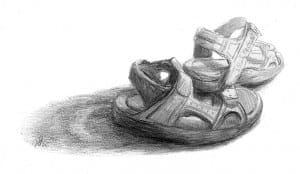A place with no tears
By LORRAINE V. MURRAY, Commentary | Published July 9, 2015
I used to cry about nearly everything when I was a child. I was fat, and kids jeered at me, and I cried. There was a chipmunk I fed by hand at my aunt’s house in the country, and on one visit she told me he had been run over by a car, and I wept the entire night.
When my parents punished me, I burst into tears, and when my sister and I argued, I sobbed. Later, when I lost my parents in my 20s, I cried for so long and so hard that the tears just dried up.
Over the years these raw wounds finally healed, and I could look at family photos without sinking into sadness—but every so often, out of the blue, the grief will bubble to the surface and overflow.
Recently, while leaving church I glimpsed an elderly woman who reminded me for just a second of my mother in her last days.
I could see in my mind’s eye the times my mother would go shopping with me even when she was too weak to walk—and how she would sit in a nearby chair watching while I perused the racks. Suddenly I felt ensnared in a giant web of loneliness as I realized she’s been gone for decades—and I still miss her.
Then I picked up the newspaper and saw bodies of tourists strewn on the beach in Tunisia where a terrorist attack had shattered a peaceful afternoon at the sea and claimed at least 38 lives. There was a heartbreakingly lonely pair of sandals shown—the exact kind my husband wears—near a blood-spattered book on the sand.
I also read about people dying in a shooting in Emanuel African Methodist Episcopal church in Charleston, South Carolina, while they were gathered in prayer and Bible study. Out of the blue a stranger walked in, joined their circle for an hour—and then proceeded to murder nine of them in cold blood.
These kind people had welcomed him into their midst, no doubt remembering Christ’s admonition: “I was a stranger and you welcomed me.”
Amazingly enough, out of this dark event at the church came a piercing ray of light, when the relatives of the victims, a few days later, offered forgiveness to the alleged perpetrator.
Where does such mercy come from? It certainly isn’t created on the spot. I would say it comes from years of reading the Bible closely, praying fervently—and practicing forgiveness in small ways.
When was the last time I prayed in the adoration chapel? I wondered. I know I’ve made plans to go there countless times, but something always gets in the way. That day, with my heart heavy with sadness, I drove straight over, eager to meet the one waiting there for me.
There were no cars outside the church and no one in the chapel. I went up to the altar, moved the big icon that covers the Blessed Sacrament when no one is there and bowed low to the Lord.
“I have you all to myself,” I whispered—and then in the velvety, prayerful silence, I poured out my heart quietly and tearfully to him, telling him about missing my mother, worrying about the direction the world is taking with violence and anger parading on the nightly news.
At home, I told my husband about all the things preying on my mind, and then apologized when a few tears hit his shirt. “No need to apologize,” he assured me. “Like Tolkien said, not all tears are evil.’”
I realized he’s right. Some tears are good, the kind that bring us closer to God. The kind that spur us to run to him and unburden our hearts—and help us realize we can’t make it alone.
The tears we shed for all the sadness in the world, for our lost mothers, for our brothers and sisters in Christ on that beach in Tunisia, for the fellow who left his sandals there, and for our brothers and sisters in the Charleston church that night.
May the promise of the Book of Revelation prove true for them, that God will welcome them to a place where there will be no more crying, no more pain—and where he will gently “wipe every tear from their eyes.”
Lorraine Murray is the author of eight books, most recently a Catholic cozy mystery, “Death Dons a Mask.” Artwork for this column is by Jef Murray. Readers may email the Murrays at lorrainevmurray@yahoo.com.